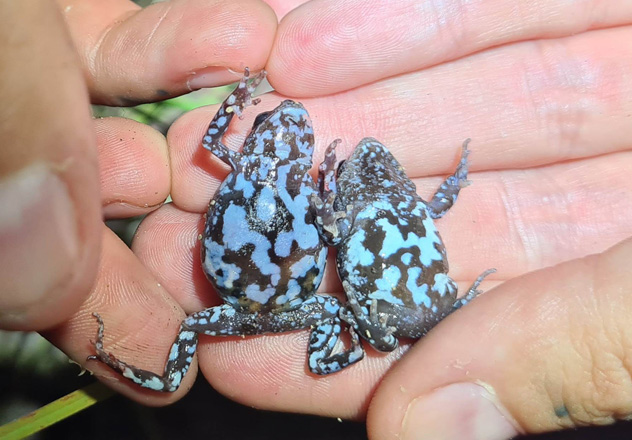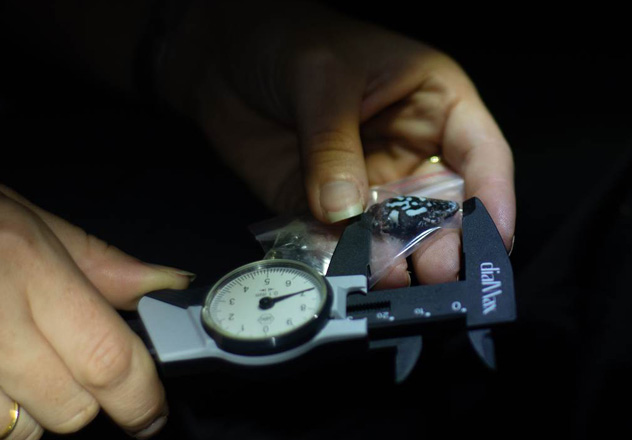By Jess Teideman, Science Writer
From deep in a grass tussock at Mount Zero-Taravale Wildlife Sanctuary in Queensland’s Paluma Range, comes the croaking ‘arrk’ of the Magnificent Brood Frog (Pseudophryne covacevichae). It’s calling in response to a yell of “hey, frog” from ecologist Emily Rush, who is studying the species as part of her PhD at James Cook University.
First found near Ravenshoe and Herberton on the Atherton Tablelands and only described in 1994, there is very little known about this cryptic, endangered species. In 2013 they were found in the Paluma Range by James Cook University researchers, extending the known distribution to the south by 160 kilometres, and in 2014 Australian Wildlife Conservancy (AWC) ecologists confirmed the species’ presence at Mount Zero-Taravale for the first time. The upland sclerophyll forest at the sanctuary turns out to be a southern stronghold for the frogs.
Supported in the field by AWC, Emily’s research aims to resolve the geographic distribution of the species, and includes genetic analysis to determine the connectivity between populations and their overall health. Through her fieldwork, Emily hopes to reveal the environmental preferences of these tiny frogs and assess the threats to their conservation. By supporting this project, AWC will better understand how to improve our monitoring programs at Mount Zero-Taravale, and refine our land-management practices to preserve the habitat in which they live.
 Emily Rush
Emily Rush
Magnificence in micro
‘Magnificent’ is a great descriptor for this little frog, which grows to only three centimetres and weighs about half as much as a five-cent coin. Like some other members of the genus Pseudophryne they are brightly coloured, with a reddish-brown body and upper arms of vibrant yellow. They also have a bright red triangular patch extending from the upper snout to the forehead, which continues in a line along the back, ending in a bright yellow stripe. Their belly is mottled black and white in a unique pattern that can be used to identify individuals.
Magnificent Brood Frogs inhabit shallow, ephemeral drainage lines along small streams in open eucalypt woodlands above 700 m elevation. During the wet season, they frequent grassy tussocks and leaf litter in these areas to call for a mate and lay their eggs. The short call of the males can be heard on warm, wet nights from October to May. The female lays her eggs in a small cluster under moist leaf litter along a drainage line or near a shallow creek. The nest is built by the male and tadpoles hatch out into flowing water after rains flood the nest.
Finding a tiny frog in a big forest
Targeted surveys were first conducted at Mount Zero-Taravale in 2021 when acoustic monitors were used across the property to identify additional populations. These surveys resulted in an increase of known sites from six to 12, making the sanctuary a stronghold for the species and underscoring the importance of the area as home to the largest known population location.
Finding the frogs in the tall, thick grass can be difficult, but the males are known to be very vocal during the wet season, and very territorial, often competing with one another to be the loudest in the landscape. Any noise made while looking for them in the sclerophyll forests often results in a vocalisation, which can be used to pinpoint a location.
Previous records consisted only of the more conspicuous males, but during surveys in 2022, Emily identified female Magnificent Brood Frogs for the first time, when she found paler individuals alongside calling males and near breeding sites.
 Mel Christi/AWC
Mel Christi/AWC
Looking to the future
Consistent monitoring of the Magnificent Brood Frog population at Mount Zero-Taravale will be critical in the coming years and decades, as they face changing conditions.
Overall, the outlook for wet tropics frog species is sombre; models forecast that up to 35% of the region’s amphibians are likely to decline under projected climate scenarios. As terrestrial breeders, Magnificent Brood Frogs rely on soil moisture and access to standing water for breeding success. Occupying a fragmented range in a narrow altitudinal band may put the species under increased pressure.
Known threats to the species include habitat loss and degradation through grazing, changed fire regimes, and road and infrastructure development. Grazing and trampling by feral herbivores have the potential to degrade the seepage areas and grasses used by the frogs for breeding. Roads and development can alter the water quality of an area and may affect seepage areas and streams.
Mount Zero-Taravale is a reliable refuge for the species as it is protected from development and it is actively managed for cattle and fire.
What is AWC doing?
AWC has implemented an ecological burn program on Mount Zero-Taravale, and continues to manage cattle and pigs though our feral herbivore management program. AWC has fenced feral cattle out of Magnificent Brood Frog habitat, and we conduct pig management
as required.
Read and download the full issue of Wildlife Matters here.
Listen to our 'AWC in Conversation' webinar with Emily about her research
Watch now